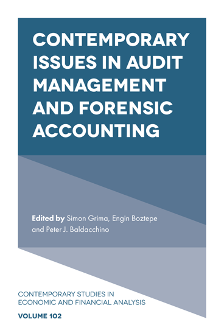
Index
Contemporary Issues in Audit Management and Forensic Accounting
ISBN: 978-1-83867-636-0, eISBN: 978-1-83867-635-3
ISSN: 1569-3759
Publication date: 10 February 2020
Citation
(2020), "Index", Grima, S., Boztepe, E. and Baldacchino, P.J. (Ed.) Contemporary Issues in Audit Management and Forensic Accounting (Contemporary Studies in Economic and Financial Analysis, Vol. 102), Emerald Publishing Limited, Leeds, pp. 334-340. https://doi.org/10.1108/S1569-375920200000102002
Publisher
:Emerald Publishing Limited
Copyright © 2020 Emerald Publishing Limited
INDEX
Index
Note: Page numbers followed by “n” with numbers indicate notes.
- Prelims
- Chapter 1: An Empirical Analysis on Students’ Cheating Behavior and Personality Traits in the Context of Fraud Triangle Factors
- Chapter 2: The Effects of Big Data on Forensic Accounting Practices and Education
- Chapter 3: Forensic Accounting Education: An Evaluation of Perception of Students and Certified Public Accountants
- Chapter 4: Financial Information Manipulation and Its Effects on Investor Demands: The Case of BIST Bank
- Chapter 5: The Current Situation and Prospects of the Profession of Judicial Advisory in Turkey: A Research on Lawyers
- Chapter 6: Insurance Fraud: The Case in Turkey
- Chapter 7: Rationality in Decision-Making and Deterring Corporate Fraud
- Chapter 8: Explaining Heterogeneity in Risk Appetite and Tolerance: The Turkish Case
- Chapter 9: An Analysis of Fraudulent Financial Reporting Using the Fraud Diamond Theory Perspective: An Empirical Study on the Manufacturing Sector Companies Listed on the Borsa Istanbul
- Chapter 10: Detection of Accounting Frauds Using the Rule-Based Expert Systems within the Scope of Forensic Accounting
- Chapter 11: Financial Statement Manipulation: A Beneish Model Application
- Chapter 12: The Evaluation of the Criteria for the Selection and Change of the Independent Audit Firm Using the AHP Method
- Chapter 13: The Forensic Accounting Profession and the Process of Its Development in the World
- Chapter 14: Forensic Accounting and Fraud Audit in Turkey (2008–2018): An Academic Literature Review and Classification
- Chapter 15: The Views of Turkish Accounting Academics about the Skills of the Forensic Accountant
- Chapter 16: Financial Crime: A Review of Literature
- Chapter 17: Social Auditing and Its Applicability to Maltese Co-Operatives
- Chapter 18: Challenging the Adequacy of the Conventional ‘Three Lines of Defence’ Model: A Case Study on Maltese Credit Institutions
- About the Contributors
- Index